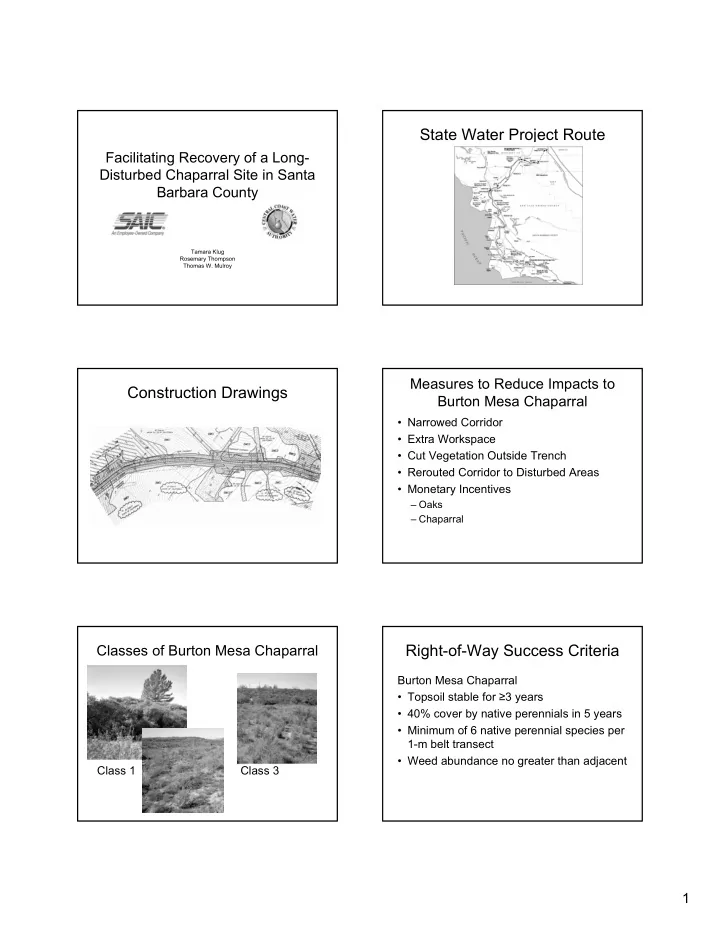

State Water Project Route Facilitating Recovery of a Long- Disturbed Chaparral Site in Santa Barbara County Tamara Klug Rosemary Thompson Thomas W. Mulroy Measures to Reduce Impacts to Construction Drawings Burton Mesa Chaparral • Narrowed Corridor • Extra Workspace • Cut Vegetation Outside Trench • Rerouted Corridor to Disturbed Areas • Monetary Incentives – Oaks – Chaparral Classes of Burton Mesa Chaparral Right-of-Way Success Criteria Burton Mesa Chaparral • Topsoil stable for ≥ 3 years • 40% cover by native perennials in 5 years • Minimum of 6 native perennial species per 1-m belt transect • Weed abundance no greater than adjacent Class 1 Class 3 1
Right-of-Way Success Criteria Right-of-Way Success Criteria Oaks in Burton Mesa Sand Mesa Manzanita Chaparral • Minimum 4 years • Minimum 1 inch basal survival diameter • 3 years with no • Minimum 3 feet tall irrigation + 2 years with no protection • Vigorous appearance • Normal form and • 3 years with no irrigation morphology with + 2 years with no vigorous condition herbivore protection Burton Mesa Mitigation Site Goal To initiate and facilitate the recovery 25 acres of non-native annual grassland to habitat dominated by native woody vegetation typical of Burton Mesa Overview photograph taken in March 1997 Site in 1938 Site in 1956 2
Site in 1995 Challenges Mitigation Plan Fence Design • Fencing • Experimental approach • Burn • Planting methods • Seeding • Sampling plan • Container plants • Reference area • Bird perches (control) • Irrigation • Target area • Planting plan Burn Seeding • Photo of burn Table 2. Seed Mix Species lb. Common name (Scientific name) per acre California sagebrush (Artemisia californica) 2 Mountain mahogany (Cercocarpus betuloides) 0.5 Mock heather (Ericameria ericoides) 0.7 California buckwheat (Eriogonum fasciculatum) 2.5 Deerweed (Lotus scoparius) 0.4 Dune lupine (Lupinus chamissonis) 1 Bush monkeyflower (Mimulus aurantiacus) 0.3 Black sage (Salvia mellifera) 0.2 Total 7.1 3
Layout of Enclaves Bird Perches Devices used to Protect Plantings Species planted in Enclaves � Chamise (Adenostoma fasciculatum) � Purisima manzanita (Arctostaphylos purissima) � Coast ceanothus (Ceanothus cuneatus var . fascicularis) � Coast live oak (Quercus agrifolia) � Coffeeberry (Rhamnus californica) � Redberry (Rhamnus crocea) Black sage (Salvia mellifera) � � Sand almond ( Prunus fasciculata var. punctata ) Survival of Plantings with Different Burton Mesa Mitigation Site Protective Devices Overview photograph taken in April 2000 4
Height of Plantings with Different Height of plantings under existing Protective Devices Shrubs Impacts of Deer Browse on Site in 2004 Coffeeberry Photographs taken in October 2003 BMMS Site Lessons Learned • Nursery • Durability of protection devices • Total cost and funding • Quality of supplies Photographs taken in March 2003 • Repair costs Reference area Mitigation Site • Timelines for success • Coordination with regulators 5
Recommend
More recommend